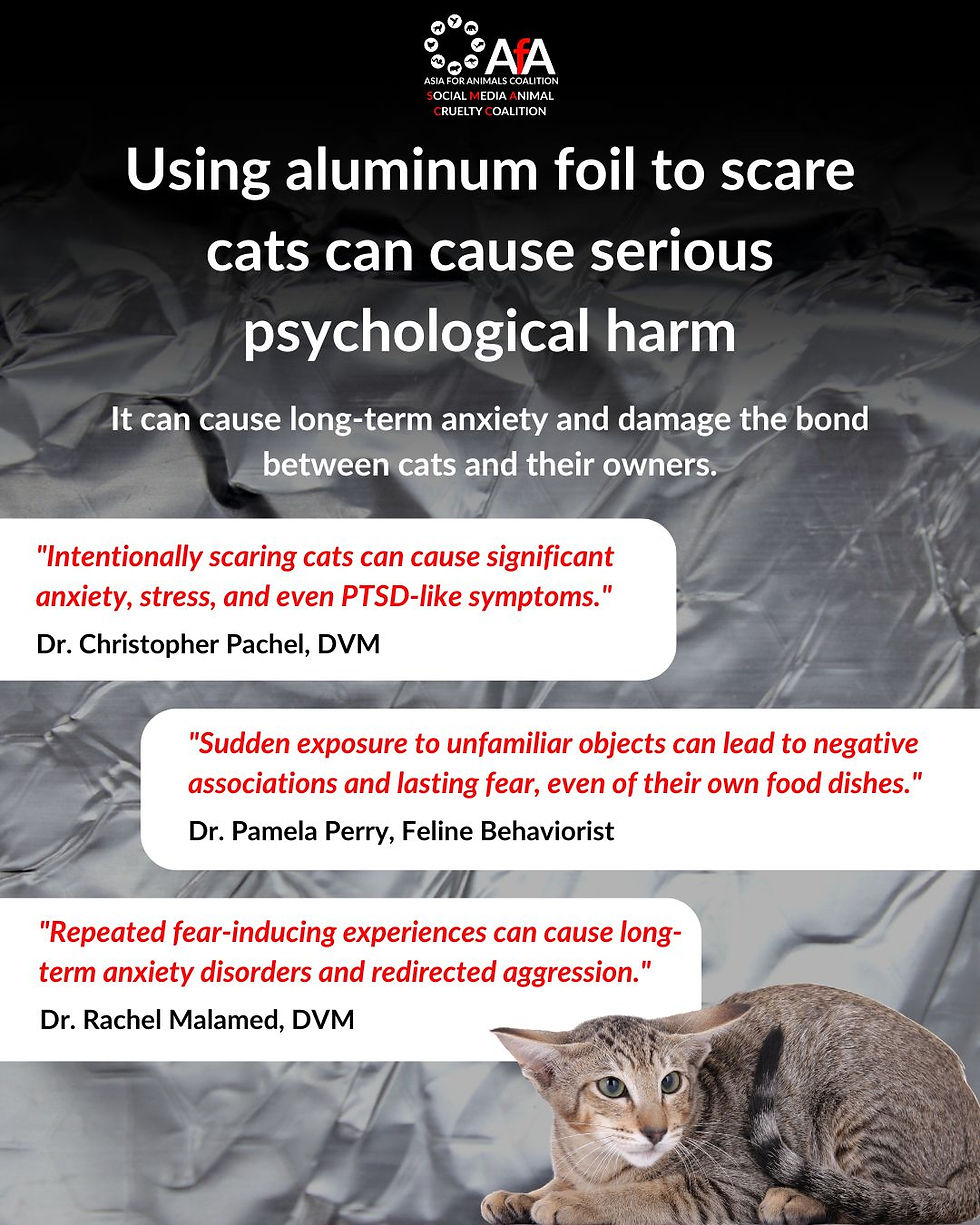The Harmful Trend of Scaring Cats with Tin Foil: Why It Needs to Stop
- Szuching Chi - AfA Coalition
- 2 days ago
- 3 min read
In recent years, social media has been flooded with viral videos of cats reacting fearfully to everyday objects like cucumbers and aluminum foil. While these videos may seem entertaining and harmless, they can harm feline well-being. Deliberately inducing fear in cats for online content is not only unethical but can also result in long-term behavioral and psychological issues.

Why are cats scared of tin foil?
Cats often show fear or anxiety when confronted with aluminum foil because it affects their acute senses in several ways:
Hearing sensitivity: The crinkling sound of tin foil can produce ultrasonic frequencies that, while inaudible to humans, can irritate cats' sensitive ears.
Unfamiliar texture: The unpredictable texture and movement of aluminum foil can be distressing, triggering an instinctive fear response.
Visual confusion: Foil's reflective and shiny nature can create disorienting light patterns, further unsettling cats.
Expert opinions on stress and anxiety
We have sought expert opinion from one of SMACC’s member organizations, Cats Protection, the UK's largest cat welfare organization. Their Central Behaviour Officer, Daniel Warren-Cummings BSc (Hons), MSc (AWSEL), has shared his concerns about this harmful trend:
"There are multiple concerns with a trend like this, both physical and mental. As one can see from the reactions in the video, there is a risk of physical injury to the cat as they move away so dramatically. There are added welfare concerns, as many of these cats are showing severe acute stress responses, which have an immediate negative effect on the cat and may also impact the cat in the longer term, jumping up, if this is a regular occurrence. Cats have evolved from part-arboreal animals and thus often seek to get off the ground as per their ethology. Thus, not only is this trend affecting the cat, it is missing the point about why cats jump up on surfaces, and actually, to meet their needs, we should provide appropriate vertical space for them."
He further emphasizes that intentionally scaring cats goes against the principles of humane treatment:
"More generally, this is a continuing trend of scaring cats. Cats are sentient animals, and we shouldn’t be promoting them or looking for the next way to scare them. We wouldn’t stand for it if there were a trend encouraging an equal level stress response from children; it would be considered cruel."
Imagine deliberately scaring a child just to film their fearful reaction—most people would see that as mean-spirited or even cruel. The same standard should apply to animals; cats are sentient beings capable of feeling fear and stress and deserve the same respect and care.
Like the infamous "cats scared of cucumbers" trend, using aluminum foil to frighten cats intentionally can lead to significant stress and anxiety. Leading veterinary experts have warned against such pranks:
Dr. Christopher Pachel, DVM: Intentionally scaring cats can cause significant anxiety, stress, and even PTSD-like symptoms.
Dr. Pamela Perry, a feline behaviorist at Cornell Feline Health Center, explains that sudden exposure to an unfamiliar object, like tin foil, can lead to negative associations with essential resources, such as food dishes or litter boxes, potentially causing lasting fear and behavioral issues.
Dr. Rachel Malamed, DVM: Repeated exposure to fear-inducing stimuli can result in conditioned fear responses, redirected aggression, and long-term anxiety disorders in cats.

The long-term impact of fear-based content
Startling cats for entertainment may generate likes and shares online, but the long-term impact on the animals’ well-being can be severe:
Increased reactivity and aggression: Cats subjected to frequent intentional scares may become more reactive or aggressive as a defense mechanism.
Generalized fear: Cats may develop fear not just of aluminum foil but of similar stimuli, such as other crinkling noises, shiny objects, or sudden movements.
Negative associations with essential resources: If a cat is scared near their food or litter box, they may start avoiding these areas, leading to eating disorders or inappropriate elimination.
Erosion of trust in owners: Repeatedly subjecting a cat to pranks can damage the bond between the pet and its caregiver, reducing overall quality of life.
A Call to Action for Pet Owners and Content Creators
Instead of using aluminum foil to startle cats for entertainment, pet owners should focus on positive and enriching interactions that support their well-being. Social media platforms must also take responsibility by discouraging content promoting animal distress.
By promoting ethical content creation and spreading awareness about the harmful effects of fear-based videos, we can protect animals from unnecessary stress while fostering responsible pet ownership.
Let’s choose kindness over cruelty and create a social media environment that respects the well-being of all animals!

Sources:



Comments